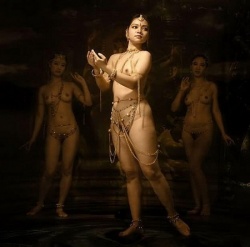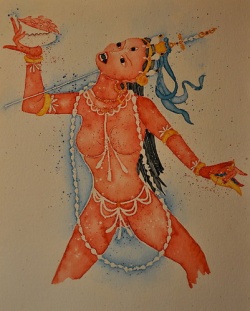Dakini, Khadroma, Khandro
Skt., dakini
Tib., mKha-'gro-ma
Sky Dancer, Sky Walker, Queen of Space]]
She Who Moves on the Highest Level of Reality
"The Dakini is playful" has once been written by Chogyam Trungpa, and to many beginning readers of Tantric literature she will also be quite confusing; or at least the name will be. Fact is, that dakini has a variety of uses and meanings which can often be discerned only through the particular context in which the term is used:
Generic Sanskrit name for a type/group of female deities the number of which is said to be 100.000 myriad's. They appear in both Hindu and Buddhist myths, iconography and scriptures; usually sky-clad - i.e. bare.
In popular Indian folklore, a dakini are regarded as semi-divine beings and is often seen as a malignant spirit, demoness or witch-like hag.
In Buddhist Ladakh, dakinis enjoy a much better reputation than in India. Here, for example, 500.000 of them are invited to a celebration of marriage in order to bestow their blessings and good fortune on the young couple; a custom still alive today.
In some cases, Dakini is the personal name of an individual goddess, as in the case of an attendant of Chinnamasta, as well as in case of the goddess ruling the Muladhara Chakra.
In Vajrayana, it is a designation for the wrathful and semi-wrathful female deities among the yidam. Although most of the translated literature uses the Sanskrit term - even in Tibetan texts - the Tibetan khadroma (khandro) is much more woman-positive; indicating these deities/women as females who move on the highest level of reality. Their nudity is said to symbolize the diamond-like clarity of the truth they unveil. In the Bardo Thödol, a dakini is defined as the "feminine energy principle, associated with knowledge and intelligence, which may be either destructive or creative".
In yet other instances, dakini is used as an honorary title for an enlightened woman, a living incarnation of a goddess; and for female initiates practicing ritual sexuality. These "Female Buddhas", as research has shown, have been very instrumental in defining and spreading the Vajrayana teachings, although the credit for this has often gone to male practitioners and/or masters.
In Tibet, Dakini is also a personal name.
We must certainly not be misled by those authors who simply call a dakini an 'emanation' or 'consort' of Buddha So-and-so. Although Buddhist Tantra ascribes a less energetic dynamism to the female pole than does Indian Tantra, the dakinis are certainly equal - if not superior - to the male deities. In the context of the Tantric teaching
that enlightenment, wisdom and liberation are achieved through a fusion of method and goal, it is the goal that is seen as the female aspect (the dakini) and the method/path as the male (see Inner Tantras).

